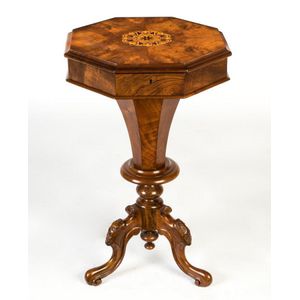Victorian Walnut Work Table with Satinwood Inlay and Carved Base
You must be a subscriber, and be logged in to view price and dealer details.
Subscribe Now to view actual auction price for this item
When you subscribe, you have the option of setting the currency in which to display prices to $Au, $US, $NZ or Stg.
- Satinwood - Satinwood is a dense pale gold coloured timber that was imported into Britain in the second half of the 18th century, and early 19th centuries from the East Indies and the West Indies. The name derives from the satin-like surface sheen when the timber is polished.
It was used in the solid, as a veneer and in inlays. As well as furniture, satinwood was used for making musical instruments, barometers, boxes and clocks.
It will usually be found on only the very best quality objects, presumably because of of its cost at the time. - Foliate - Decorated with leaves or leaf-like forms.
- Tripod Base - A type of base used on small tables in the 18th and 19th century, consisting of either a stem to a three legged pillar, or three legs attached to the top. The former was derived from the candle stand, which has a small top and a long stem, terminating in the three legged pillar.
In the 19th century this type of base was popular on wine and occasional tables, and its use extended into larger centre, breakfast and drum tables. - Victorian Period - The Victorian period of furniture and decorative arts design covers the reign of Queen Victoria from 1837 to 1901. There was not one dominant style of furniture in the Victorian period. Designers used and modified many historical styles such as Gothic, Tudor, Elizabethan, English Rococo, Neoclassical and others, although use of some styles, such as English Rococo and Gothic tended to dominate the furniture manufacture of the period.
The Victorian period was preceded by the Regency and William IV periods, and followed by the Edwardian period, named for Edward VII (1841 ? 1910) who was King of the United Kingdom and the British Dominions and Emperor of India for the brief period from 1901 until his death in 1910.
This item has been included into following indexes:
Visually similar items

A marquetry inlaid burr walnut sewing table, English, 19th century, 74 cm high, 48 cm diameter

Card table, late Victorian walnut circular top with fruitwood inlay decorations diameter 90 cm

A Victorian mahogany work table c.1880 and later. The table has a lift up top with interior compartments, and hollow pedestal column, used for needlework storage. Height 73 cm; top: 43 x 43 cm

A Victorian circular walnut sewing table. second half 19th century, the circular table with thumb nail edging, and an inlaid floral motif in ebony and satinwood to the quarter veneer panelled top opening to a partitioned paper lined interior above a scallo
